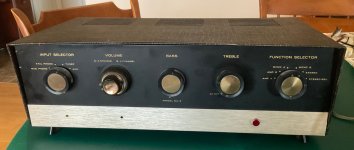I have a decent-looking, working Heathkit SA-2 amplifier for sale for $350. This unit has the famous 51-29 (made by Stancor) output transformers that are capable of excellent performance. The SA-2 is basically the stereo version of the highly-regarded Heathkit UA-1 or UA-2 mono amps while it also has a preamp and phono section. Shipping is at cost from Illinois, USA. 61821.
The unit looks acceptable for its age with a few minor scratches, but would look nice with some TLC and cleaning. I’m offering the unit for sale with the full tube complement, except the two 12AX7s and 6AN8as. The rectifier is a brand new JJ GZ34, two good used 6AU6s (I don’t see brand markings) and a matched quad of those supposedly “lightly-used” 6P14Ps from Ukraine that look well-used but measure fine.
I went through the amplifier and it is playing right now as I’m writing. Since this amplifier works, it would be ideal for someone who wants to rebuild it in phases, making sure you can hear the improvements was you go through replacing old parts. There is a slightly audible hum but otherwise sounds quite good. I performed some testing and minor updating, including installing the yellow-sheet diodes modification to protect the GZ34 rectifier.
I brought the amp up slowly and reformed the large power supply multicapacitor. It tests good, so I believe it is fine for a while. The cap feels warm but not hot even after few hours of listening. The shared cathode capacitor was replaced with a new Nichicon “Audio Grade”UKZ. I measured the other 10uF/25 V electrolytic caps (cathode bypass in phono and pre-amp) and they seem OK, so left them alone for now.
All the coupling capacitors were replaced by good Orange Drop (CDE 715) film capacitors. The small mica and ceramic caps were not replaced yet, and probably doesn’t need to be replaced at all. The under-side photo shows these new caps.
The next renovation phase would be the resistors. I spot-checked the resistors and some have drifted - some not much but others enough to justify replacement. The phase inverter resistors (47k, 1 watt) on the 6AN8a triodes are not closely enough matched to my taste. This could be the cause of the slight audible hum. I’ll leave that work to the next owner.
Below are some photos that should help you assess the amplifier condition. Shoot me questions if you have any.
The unit looks acceptable for its age with a few minor scratches, but would look nice with some TLC and cleaning. I’m offering the unit for sale with the full tube complement, except the two 12AX7s and 6AN8as. The rectifier is a brand new JJ GZ34, two good used 6AU6s (I don’t see brand markings) and a matched quad of those supposedly “lightly-used” 6P14Ps from Ukraine that look well-used but measure fine.
I went through the amplifier and it is playing right now as I’m writing. Since this amplifier works, it would be ideal for someone who wants to rebuild it in phases, making sure you can hear the improvements was you go through replacing old parts. There is a slightly audible hum but otherwise sounds quite good. I performed some testing and minor updating, including installing the yellow-sheet diodes modification to protect the GZ34 rectifier.
I brought the amp up slowly and reformed the large power supply multicapacitor. It tests good, so I believe it is fine for a while. The cap feels warm but not hot even after few hours of listening. The shared cathode capacitor was replaced with a new Nichicon “Audio Grade”UKZ. I measured the other 10uF/25 V electrolytic caps (cathode bypass in phono and pre-amp) and they seem OK, so left them alone for now.
All the coupling capacitors were replaced by good Orange Drop (CDE 715) film capacitors. The small mica and ceramic caps were not replaced yet, and probably doesn’t need to be replaced at all. The under-side photo shows these new caps.
The next renovation phase would be the resistors. I spot-checked the resistors and some have drifted - some not much but others enough to justify replacement. The phase inverter resistors (47k, 1 watt) on the 6AN8a triodes are not closely enough matched to my taste. This could be the cause of the slight audible hum. I’ll leave that work to the next owner.
Below are some photos that should help you assess the amplifier condition. Shoot me questions if you have any.






